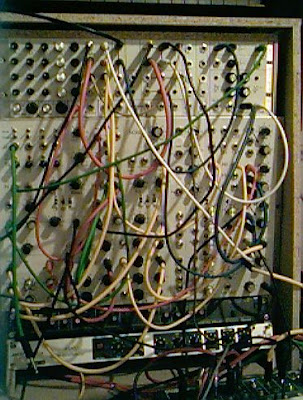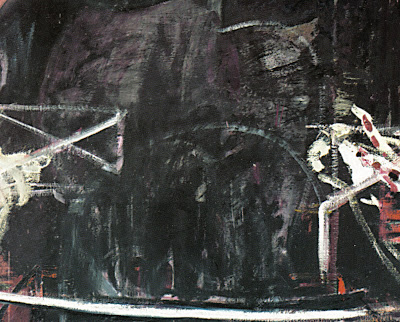by Corry Shores
[Search Blog Here. Index-tags are found on the bottom of the left column.]
[Central Entry Directory]
[Corry Shores, Entry Directory]
[The following is my presentation that I gave at the Dutch Association of Aesthetics conference
in Ghent, Belgium, May 2011.]
[May I sincerely thank the sources of the images
Concrete Rules and Abstract Machines
awesome-art.com
dl.ket.org
Joy A's flickr / Joy A
all about Weybridge. / Rachael Talibart
students.sbc.edu
russianpaintings.net
wikipedia
sai.msu.su
Machotka
analog-synth.de
theatreorgans.com / synthtech.com
G. Fernández - theartwolf.com
travel.webshots.com and rajbaut
Credits are given below the image and at the end.]
Painting Divergences in Merleau-Ponty and Deleuze

[Thanks Concrete Rules and Abstract Machines]
Deleuze is often considered an anti-phenomenologist. He even writes disparagingly of phenomenology’s lived-body that we find in Merleau-Ponty’s thinking. Nonetheless, Deleuze still generated an original theory of phenomena. So rather than determining whether Deleuze was a phenomenologist or an anti-phenomenologist, we might instead attempt to formulate what a Deleuzean phenomenology would be like. For Merleau-Ponty, phenomena are possible on account of three levels of harmonic integration: among the parts of the phenomenal world, among our bodily parts functioning in sensation, and between our body and the world enveloping us. All these overlappings bind us into the flesh of the world. Yet, a Deleuzean phenomenology would be based on precisely the opposite principles: the phenomenal world consists of incompatible differences shockingly forced upon us, all while our body functions disjunctively within itself and with our surroundings. Both Merleau-Ponty and Deleuze express their different views through their seemingly convergent readings of quotations attributed to Cézanne. But as we will see, there is one line in Deleuze’s commentary that indicates his different fundamental principles.
Both Merleau-Ponty and Deleuze turn their focus to painters when at times describing sensation and perception. Painters exercise a certain phenomenal sensitivity. They do not just see, they also become aware of how we see. Merleau-Ponty thinks painters have a ‘secret science,’ because they live purely in our emersion in the world, which they visually express in their art. Cézanne aimed to paint not the immediate impressions, like the impressionists, nor did he paint the finished perception as a photo-realistic rendition. Instead, he wanted to paint the way our eyes and minds deal with our impressions. We see in his earlier attempts that objects are often misshapen.

(Thanks awesome-art.com)
Cups and saucers, for example, should normally appear elliptical, but Cézanne paints them with swollen ends. Fruit that should appear more spherical are also deformed.

(Thanks dl.ket.org)
These still lifes depict not a photographic representation of reality, but rather allow us to enter into the process of objects coming into formation in our perception. What interests us is how Merleau-Ponty accounts for the ways and reasons that our perceptions come about through integrations.

(Joy A's flickr. Thanks Joy A)
For Merleau-Ponty, our phenomenal parts integrate by means of our horizonal awareness. Consider if we view a red carpet. Each part of our perception looks its particular way on account of the other qualities and objects expressing themselves in that appearance, for example, the overlaying shadow that tinges the color or the illuminated portions that lighten its tone.
We are not surprised when looking up to see the source of light and the objects that block it. The red’s particular shaded or lighted look refers our mind to things not explicit in what we directly perceive.

(Thanks all about Weybridge. Thanks Rachael Talibart.)
Or consider how a stream’s surface might reflect the brownish hue of an overlying bridge. When looking at the water, we are not directly aware of the bridge, but it is being implicitly spoken or announced by the stream’s color. The stream would appear differently to us were it not for its integrated relation with the bridge above it. And likewise, when looking up at the bridge, we see in its appearance the motion of the water, reflecting up upon it. Our minds have an awareness of these related phenomena, but they are not in the forefront of our attention. As implicit phenomena, they hover at the edges of our awareness.
This horizonal integration of phenomenal objects is so involved that to see one object from a given perspective is also to have on the horizon of our awareness the way that object looks from the perspectives of every other object facing it. Merleau-Ponty illustrates this effectively with the arm-shadow in Rembrandt’s The Night Watch.
Notice how the man in the foreground holds-out his arm, which casts a shadow on the man standing next to him.
We do not merely see his arm from just our perspective; we also see it as if we were looking from his right side at the angle of the light source, because the shadow we see from our perspective presents to us the appearance of his arm from the sun’s perspective.
The parts of our body also have horizons that integrate, with each sense giving us phenomenal data that is on the margins of the other senses as well.“ Synaesthetic perception is the rule,” Merleau-Ponty writes, continuing, “The senses intercommunicate by opening-on to the structure of the thing. One sees the hardness and brittleness of glass, and when, with a tinkling sound, it breaks, this sound is conveyed by the visible glass."
So here we may display the three sorts of integrations at work in phenomenal appearances. The parts of the world integrate, because each part of our perception of the world has the other parts on the horizon of our awareness. Such perceptions are possible because the parts of our body, including our sense organs, themselves have the other senses on their horizon, and in that way integrate synaesthetically. And it is on account of our sympathetic interaction with the world that we may come into phenomenal contact with it.
Before turning to the Cézanne material, let’s note Merleau-Ponty's account of the way the child perceives colors before learning the names for them.
Children first are only able to distinguish colored things from non-colored ones. Next they differentiate warm and cool shades of colored regions. Finally, they can discern different distinct colors. And then gradually, they can distinguish further variations of each color. Merleau-Ponty says that this is not because the child originally perceived the different specific colors in their determinacy, being only unaware of the colors’ identities. Merleau-Ponty instead says that the colors were originally seen in an | indeterminate form, and only gradually does the child come to constitute them distinctly. In other words, the child sees different colors but not so much the distinctions between them, although these differences hang implicitly on the horizon of their awareness. There are relations, then, between the colors that are seen, but only implicit ones. As Cézanne writes, these are “the confused sensations which we bring with us when we are born.”
Cézanne describes his initial experience when painting his landscape or motif as involving this raw encounter with the visual givenness of the world.
I breathe the virginity of the world [...]. A sharp sense of nuances works on me. I feel myself colored by all the nuances of infinity. At that moment, I am as one with my painting. We are an iridescent chaos. I come before my motif and I lose myself in it.
Deleuze speaks of filmmaker Stan Brakhage as having explored a “Cézannian world before man, a dawn of ourselves, by filming all the shades of green seen by a baby in the prairie,” and he refers us to a text quoting Brakhage describing this world. Yet, we have Brakhage himself reciting that passage in this interview.
[Alternate version: "Imagine an eye unprejudiced by compositional logic, an eye which does not respond to the name of everything, but which must know each object encountered in life through an adventure of perception. How many colors are there in a field of grass to the crawling baby unaware of “green?” How many rainbows can light create for the untutored eye? Imagine a world alive with incomprehensible objects and shimmering with an endless variety of movement and innumerable gradations of color. Imagine a world before the “beginning was the word."]
So Cézanne begins by taking up such a stance where he views his landscape with an untutored eye. Yet what he sees is not merely an iridescent chaos, because from the beginning, the geometry of the geological structures has already begun taking formation in his perception. In both Deleuze’s and Merleau-Ponty’s commentaries, we see they take note of this emergence of phenomena, although Deleuze accents the chaotic origins a little bit more.
Cézanne continues,
slowly geographical foundations appear, the layers, the major planes form themselves on my canvas. Mentally I compose the rocky skeleton. […] A pale palpitation envelops the linear elements. The red earths rise from an abyss. […] Geometry measures the earth.
So he begins with a primordial chaos of visual perception. In this beginning stage the general geometrical forms are given as emergences of geological structures. But he does not continue by painting these formations as they find more determinate boundaries, but rather makes them collapse by submitting them to a catastrophe: he converts them into something completely unlike how they began. He turns geometry into color. Again, we see by comparing Deleuze's and Merleau-Ponty's commentaries that they say essentially the same thing, but with a little more emphasis on the chaotic in Deleuze's case.
Cézanne first sketched the linear features of the structures roughly in charcoal. But instead of working on making those lines clearer and more definite, he instead worked to use color patches to create volumes encompassing the figure. When arriving at this state of harmony and equilibrium in the color tone and saturation, Cézanne declares:
I have my motif. . (He clasps his hands together [..] intertwining his fingers) […] I join [nature’s] wandering hands . . . I pick her tonalities, her colors, her nuances […]. I fix them; I bring them together . . . They form lines. They become objects, rocks, trees, without my thinking about it. They take on volume. They have color values. If these volumes and values correspond on my canvas and in my senses, to my planes and patches, that you also see before you, well, my painting joins its hands together.
We can see in their commentaries that both Deleuze and Merleau-Ponty stress this idea of the intertwining of phenomenal parts.
So far, both Deleuze’s and Merleau-Ponty's commentaries seem to fall in line. However, Deleuze introduces a new concept when he writes: “The diagram is exactly what Cézanne called the motif.” Deleuze gives the most detailed explanation of painted diagrams in his analysis of Francis Bacon’s artwork. Here we see Bacon explaining his aim of rendering reality in the alternate medium of painted imagery.
Bacon gives us the experience of immediate reality not by painting photo-realistically, but rather by forcing our bodies to contend with incompatible differences. Reality in its immediate givenness is a paradox to our senses. Objects of our experience are recognizable only secondarily after we had a moment to process the information we see. But the absolutely immediate impact of reality is un-processed newness.

(Thanks wikipedia)
The problem Bacon faces is that if he painted recognizable and comprehendible imagery, the viewer would process the visual data and convert it into a summarized narrative, for example, ‘this is a bird landing on a field.’ After recognizing what we see, we can then walk away and forget the image.
Bacon would begin with such a proto-formation, then make random markings like splatters or smears.
Bacon reads these new lines as if they were a diagram pointing out new directions to develop the imagery.
(Animation is my own,
made with Open Office Draw and Unfreeze,
with images thanks to www.sai.msu.su and wikipedia)
In this way, the diagram causes a catastrophic chain reaction to spread over the painting. What results is a conglomerate of images that we feel inclined to put together, and yet find it impossible to do so entirely.


(Thanks www.sai.msu.su and wikipedia)
This holds us in the paradoxical givenness of immediate reality. The diagram here is a mechanism that forces variations into what we see. It ensures that the painting maintains its phenomenal intensity, even after a prolonged view.
In a similar way, Cézanne’s color patches also do not always resemble the original thing’s colors.
Cézanne once confused a visitor who saw him paint a gray wall green. He chose his colors on the basis of how those selections would act on our minds, and in this way he was able to give us a sense of the volumes and depths of a scene without depending on outlines and shading. His color modulations turned geometry into color, intertwining our sense impressions with the structural forms around us.
But what is important is not how the color patches integrate, but rather how they differ. We feel his depth in the way that one color patch changes to another. The color-change does not tell our senses that this other part of the object has another color, but rather that it faces toward another angle, and thus is more apt to reflect flashes of color from an alternate light source.

(Thanks analog-synth.de)
Analog Modular Synthesizer

(Thanks theatreorgans.com, citing as source: synthtech.com)
We move from color-patch to color-patch much the same way that a sound-signal moves from module to module in an analog synthesizer, with each transition modifying the sound’s appearance.
So let’s consider a Deleuzean interpretation of Cézanne’s words. The color modulation in Cézanne's paintings would be a series of differential perceptions. The fingers of Cézanne's folded hands are intertwined not in integration, but as incompatible differences that are mashed together. And this does not integrate us with the world, because the world as it is given and rendered is not the same world that we sense. Regarding the integration of our body-parts, it is not evident that in Cézanne it is based on differential relations rather than integrations. Perhaps this is one reason Deleuze turns to Bacon, whose shocking artworks throw the parts of our body into disarray.
So what would it be like to do phenomenology in a Deleuzean way? I think it would be based on phenomenal differences and incompatibilities. I would like to end with Stan Brakhage’s spontaneous and eloquent account of how things phenomenally stand-out and appear to him. It seems in part to be based on phenomenal differences and incompatibilities.
Image Credits:
First Cézanne fruit painting:
http://ajnabee.tumblr.com/post/5169621182/paul-cezanne-nature-morte-with-commode-1883-87
Thanks Concrete Rules and Abstract Machines
Cézanne. Still Life, Fruit and Pitcher on Table
http://www.awesome-art.com/awesome/shop/category.aspx?catid=44&page=1&sortby=
(Thanks awesome-art.com)
Cézanne: Still Life with Apples (1890-94)
http://www.dl.ket.org/webmuseum/wm/paint/auth/cezanne/sl/apples/index.htm
Red Carpet:
http://www.flickr.com/photos/21295189@N04/3028115809
(Joy A's flickr. Thanks Joy A)
Bridge:
http://www.allaboutweybridge.co.uk/aaw/weybridge/surrey/weybridge-photos/weybridge-wey-bridges.htm
(Thanks all about Weybridge. Thanks Rachael Talibart.)
Eagle picture:
http://upload.wikimedia.org/wikipedia/commons/8/86/American_Bald_Eagle%2C_landing.jpg
(Thanks wikipedia)
Cezanne comparison images:
Machotka Pavel. Cézanne: Landscape into Art.
http://www.machotka.com/library/landscapetoart/index.htm
Analog Modular Synthesizer, vertical image
http://www.analog-synth.de/synths/formant.htm
(Thanks analog-synth.de)
Analog Modular Synthesizer, square image
http://theatreorgans.com/walnuthill/wall-frankvanaman.htm
http://www.synthtech.com/motm.html
Cézanne. Mont Sainte Victoire.
http://www.theartwolf.com/articles/50-impressionist-paintings.htm
(Thanks G. Fernández - theartwolf.com)
Mont St Victoire. la montagne Sainte-Victoire vue des Lauves, photo
http://travel.webshots.com/photo/1525735117041399610tbQuZP
(Thanks travel.webshots.com and rajbaut)
































































No comments:
Post a Comment